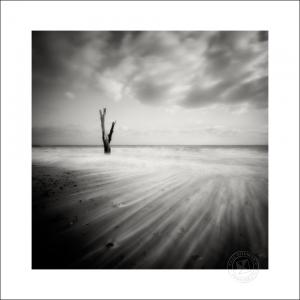
Joining us via Zoom from his home in Hampshire Paul Mitchell FRPS introduced us to pinhole camera photography in which he has been engaged for twenty odd years. His interest began in Windsor when a friend would hire a whole room, black it out, create a small hole in the blackout and with a large format camera photograph the inverted image of Windsor Castle projected on to the wall and disappear for 24 hours. Despite the complete blackout an image was produced on the film that was subsequently developed.
For Paul, pinhole camera work was about focussing on the fundamentals and getting back to basics. It is also the antithesis of the digital age and is about creating images where the image quality is unpredictable. As a graphic designer he enjoys a creative imaging tool. It is definitely not competition material. Most importantly it is “fun”!
A pinhole camera is basically a light-tight box with a hole in it but without glass acting as a lens. It is a camera obscura with a light sensitive medium to register the light using the principle that light travels in a straight line (rectilinear theory of light). The size of the pinhole determines the sharpness of the image. The smaller the hole the sharper the image. Paul demonstrates this when he can by inviting people who wear glasses for short sightedness to remove their glasses, curl their hand up to leave a tiny hole. Looking through the hole the image would be very sharp.
He explained how to make a pinhole camera having seen them made out of wheely bins, biscuit tines, shoe boxes and match boxes. Many commercially produced cameras are available. A Holga pinhole camera is widely available. They take 35mm and 120mm film and 5x4 or 8x10 format cameras are also available. He showed us his own made by Zero Cameras from mahogany and brass with film winding knobs and a pinhole cover lever and spirit level.
Pinhole camera images tend to be quite soft and ethereal. They require long exposures. Paul’s camera is equivalent to f138 compared with a minimum f22 on most digital cameras. Clouds and water can be rendered with considerable blur and you get great depth of field with millimetres in front of the camera to infinity in focus. There is also a lack of linear distortion if the camera is perfectly perpendicular to the subject. Vignetting is inevitable because of the physics of light. The cameras are also very portable. Paul recommends using film, but digital versions are available. Exposure does not have to be as accurate as with digital cameras as film offers some latitude with perhaps 3 or 4 stops either way. On a bright day a 1-2 sec exposure is needed, with 3-4 on a dull day and really dull 4-8. At the beginning and end of the ay 15-30 secs might be needed. Indoor exposure might be in minutes. A Christmas tree exposure took 2 hours. There is no viewfinder, so shots need to be lined up well and a tripod is essential. Paul scans the developed film with a 16bit linear scan to give what he calls the equivalent of a RAW file.
He then demonstrated a rather flat scanned image which he could process in Photoshop using just what he might done in the dark room to bring out the detail such as contrast and dodging and burning. He went on to demonstrate how he was able to achieve blurring of clouds and extensive depth of field with an image from a church window that was sharp from millimetres from the camera to the lead lights and even the gravestones in the churchyard. He then described a workshop with Steve Gosling at Asgarth Falls in Wensleydale with an image of the soft milky water combined with the detail of the edging bedrock. Paul then showed images of the Suffolk coast at Southwold and Aldeburgh with milky water again and interesting shapes. Most film was black and white, but some colour images were included. Fuji Velvia colour film required very accurate exposure, but colour negative film was more forgiving.
Images from steam fairs followed with the explanation that the engineers appeared to favour him over digital photographers because of a sense that they were closer to each other with the more basic elements of their respective tools. Paul then took us on a photographic tour of Britain from Northumberland to Dungeness, along the south coast including the West Pier at Brighton, the Jurassic coast to Clevedon in Somerset and then some images of London. He finished with a display of his FRPS images which were the first pinhole image display for a Fellowship.
Some viewers saw the images as reminiscent of some 19th and early 20th century images. Paul agreed that they were pictorial and then discussed some weird devices that some people do with pinhole cameras such on the inside of an egg or beer can. Solargraphs also featured in questions as did filters. Some cameras now have a screw thread for filters. After another question he discussed putting strips of film into 35mm film canisters that were left out for solargraphs but in common with the questioner had experienced their being removed from their location.
The talk was very well received by club members and visitors alike.
